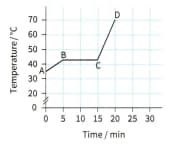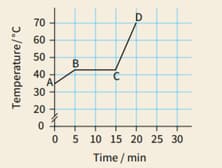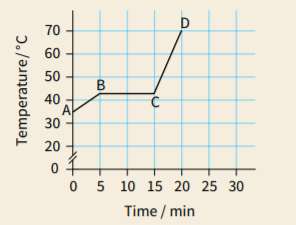In an experiment to measure the specific heat capacity of water, a student uses an electrical heater to heat some water. His results are shown. Calculate a value for the heat capacity of water. Comment on any likely sources of error.
mass of beaker = 150 g
mass of beaker + water = 672 g
current in the heater = 3.9 A
p.d. across the heater =11.4V
initial temperature = 18.5 oc
final temperature = 30.2 oc
time taken = 13.0min

Important Questions on Thermal Physics
A block of paraffin wax was heated gently, at a steady rate. Heating was continued after the wax had completely melted. The graph shows how the material's temperature varied during the experiment.
For each section of the graph (AB, BC and CD), describe the state of the material.
A block of paraffin wax was heated gently, at a steady rate. Heating was continued after the wax had completely melted. The graph shows how the material's temperature varied during the experiment.
For each section, explain whether the material's internal energy is increasing, decreasing or remaining constant.
A block of paraffin wax was heated gently, at a steady rate. Heating was continued after the wax had completely melted. The graph shows how the material's temperature varied during the experiment.
Consider the two sloping sections of the graph.State whether the material's specific heat capacity is greater when it is a solid or when it is a liquid. Justify your answer.

Temperature variation of a sample of wax, heated at a constant rate.
The first law of thermodynamics can be represented by the expression:
An ideal gas is compressed at constant temperature.
Which row shows whether and are negative, positive or zero during the change?



